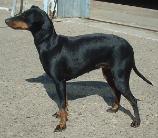
This is a placeholder text
Group text
by Ceph on 05 April 2007 - 14:04
This is true...and I do agree with it...whites are perhaps not as efficent at protection or herding because their coat color makes it difficult for them...however, on the same note...they dont have any less desire to work and there are many other working areas were lighter color makes alot of sense....Search and Rescue, Service and Guide work are all areas were the color is more visible and where visibilty is a good thing.
White actually is the absence of melanocytes which produce the white color...however, it is the skin not producing melanocytes for the hair...it still produces for the skin (hence the dark pigmentation of the leather). Being homozygous recessive for the white allele doesnt cause dogs that have the dominant allele for color to loose pigment...it just masks the color of the coat.
The Swiss use the White Shep/BBS extensivley as mountain rescue dogs...they do blend into all that snow but that is what the bright orange vest is for. lol, and the Pyrenees do it in the snow too...arent they also solid white tending dogs? I have read that they herd and protect.
But back to the blues question...would the blues and livers be any less effective than other colored dogs? Probably not...its just a different color that some people dont like.
~Cate
by Blitzen on 05 April 2007 - 15:04
White dogs can also have liver pigment.
Pyrenees are primarily guard dogs, not tenders. Their color allows them to blend in with the sheep.
by Renofan2 on 05 April 2007 - 16:04
I train with someone that has a blue shepherd. It was more noticeable when he was a pup. He just turned a year. Now it is like a smoky layer of light grey covers his fur and his eyes are blue grey (light). The coat texture on this dog is also very rough and dry.
Cheryl
by marci on 05 April 2007 - 16:04
BLUUES CLUUUES... blue are just FADED BLACK....
same with LIVER... Its also FADED BLACK...
although a TINGE of RUST is normal if the dogs about to SHED COAT
by Ceph on 05 April 2007 - 17:04
any color, white, saddle marked, sable, and bi color can carry for the liver and the blue alleles because they are all on seperate locus'. However...I have seen it less frquently in whites, though that may be in part to the fact that there are fewer of them.
Blues and livers are diluted...not faded (lol, I wasnt sure exactly what you meant :p)...actually with blues sometimes the blue pigment will darken with age. The melanocytes are not capabale of forming black pigment...It has something to do with the eumelanin vs. phaeomelanin production by the melanocytes.
by EnviroGA on 05 April 2007 - 18:04
I never said that ALL breeders culled white puppies. I was merely speaking in a generalization sense regarding several breeders. If I was at home, I would gladly pull my reference books and quote such.
As for Blue Malinois...I stand corrected. Now I'm waiting for someone to say there's such thing as a brindle Belgian Malinois or that a "Panda Shepherd" is just as good quality breeding as a black and tan Shepherd.
by beetree on 05 April 2007 - 18:04
Blitzen,
The Kuvasz is a large white herding dog, from Hungary. I do believe it snows in Hungary.
~Deb
by Sue12 on 05 April 2007 - 20:04
Ceph,
I am sure that the whites were once accepted in the SV, because the grandfather of Horand was a white shepherd!
by pod on 05 April 2007 - 21:04
There are two types of 'blue' that occur in the Shepherd; silver which could be what Sue12 has described, and dilute which is inherited as a recessive to black eumelanin pigment.
This dilute form certainly does have association with health problems, in the form of follicular dysplacia aka colour dilution alopaecia which is best known in the Dobermann but also reported in many other breeds including the Shepherd, see here -
http://www.merckvetmanual.com/mvm/index.jsp?cfile=htm/bc/70203.htm
White in the GSD has now been DNA identified to the MC1R gene, the E locus (recessive ee) and there is a commercial DNA test available.
ref: http://homepage.usask.ca/~schmutz/white.html
by Ceph on 06 April 2007 - 02:04
Schmutz is posting an article on this in the J.Hered! Awsome! I cant wait till it comes out :)
However Schmutz says that they are e/e at the extension locus, but not necissarily that it is the cause of the white color (Schmutz wonders why the color isnt reddish and from what I gather that means not entirley sure.) There's alot of variation on this one...some think it is cd/cd, some think it is cch/cch, some e/e, some think it is sw/sw...lol, more research please (cause it is so cool!)
Follicular dysplasia has been reported in the GSDs...thank you for that :)...but is not limited to liver, but the black dogs as well :)
Sue - yup, but horands grandfather wasnt registered...I believe the first GSD registered was Horand himself, though I believe some of his :) I think culling probably started around the mid 30's when the breed removed whites.
Just cause I am curious...could the silver be due to the Grey Locus (didnt think the GSD was recessive for this one)? I havent heard of a silver that isnt a blue before...but I am more ignorant on the names of the colors than I am of the genetics that cause them.
Contact information Disclaimer Privacy Statement Copyright Information Terms of Service Cookie policy ↑ Back to top




